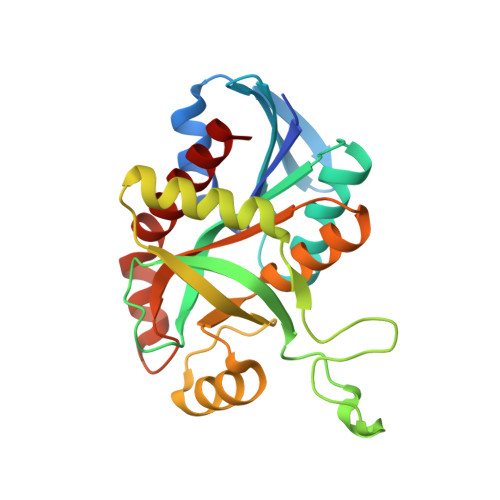Transition-State Analogues of Campylobacter jejuni 5'-Methylthioadenosine Nucleosidase.
Ducati, R.G., Harijan, R.K., Cameron, S.A., Tyler, P.C., Evans, G.B., Schramm, V.L.(2018) ACS Chem Biol 13: 3173-3183
- PubMed: 30339406
- DOI: https://doi.org/10.1021/acschembio.8b00781
- Primary Citation of Related Structures:
6AYM, 6AYO, 6AYQ, 6AYR, 6AYS, 6AYT - PubMed Abstract:
Campylobacter jejuni is a Gram-negative bacterium responsible for food-borne gastroenteritis and associated with Guillain-Barré, Reiter, and irritable bowel syndromes. Antibiotic resistance in C. jejuni is common, creating a need for antibiotics with novel mechanisms of action. Menaquinone biosynthesis in C. jejuni uses the rare futalosine pathway, where 5'-methylthioadenosine nucleosidase ( CjMTAN) is proposed to catalyze the essential hydrolysis of adenine from 6-amino-6-deoxyfutalosine to form dehypoxanthinylfutalosine, a menaquinone precursor. The substrate specificity of CjMTAN is demonstrated to include 6-amino-6-deoxyfutalosine, 5'-methylthioadenosine, S-adenosylhomocysteine, adenosine, and 5'-deoxyadenosine. These activities span the catalytic specificities for the role of bacterial MTANs in menaquinone synthesis, quorum sensing, and S-adenosylmethionine recycling. We determined inhibition constants for potential transition-state analogues of CjMTAN. The best of these compounds have picomolar dissociation constants and were slow-onset tight-binding inhibitors. The most potent CjMTAN transition-state analogue inhibitors inhibited C. jejuni growth in culture at low micromolar concentrations, similar to gentamicin. The crystal structure of apoenzyme C. jejuni MTAN was solved at 1.25 Å, and five CjMTAN complexes with transition-state analogues were solved at 1.42 to 1.95 Å resolution. Inhibitor binding induces a loop movement to create a closed catalytic site with Asp196 and Ile152 providing purine leaving group activation and Arg192 and Glu12 activating the water nucleophile. With inhibitors bound, the interactions of the 4'-alkylthio or 4'-alkyl groups of this inhibitor family differ from the Escherichia coli MTAN structure by altered protein interactions near the hydrophobic pocket that stabilizes 4'-substituents of transition-state analogues. These CjMTAN inhibitors have potential as specific antibiotic candidates against C. jejuni.
Organizational Affiliation:
Department of Biochemistry , Albert Einstein College of Medicine , Bronx , New York 10461 , United States.
















